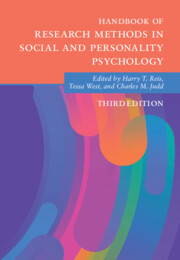Book contents
- Handbook of Research Methods in Social and Personality Psychology
- Cambridge Handbooks in Psychology
- Handbook of Research Methods in Social and Personality Psychology
- Copyright page
- Contents
- Figures
- Tables
- Contributors
- Introduction
- 1 The Romance of Research Methods
- Part I Before You Dive In
- Part II Basic Design Considerations to Know, No Matter What Your Research Is About
- 6 Research Design and Issues of Validity
- 7 Experimental Design
- 8 Quasi-Experimental Designs
- 9 Field Research Methods
- Part III Deep Dives on Methods and Tools for Testing Your Question of Interest
- Part IV Understanding What Your Data Are Telling You About Psychological Processes
- Index
- References
7 - Experimental Design
from Part II - Basic Design Considerations to Know, No Matter What Your Research Is About
Published online by Cambridge University Press: 12 December 2024
- Handbook of Research Methods in Social and Personality Psychology
- Cambridge Handbooks in Psychology
- Handbook of Research Methods in Social and Personality Psychology
- Copyright page
- Contents
- Figures
- Tables
- Contributors
- Introduction
- 1 The Romance of Research Methods
- Part I Before You Dive In
- Part II Basic Design Considerations to Know, No Matter What Your Research Is About
- 6 Research Design and Issues of Validity
- 7 Experimental Design
- 8 Quasi-Experimental Designs
- 9 Field Research Methods
- Part III Deep Dives on Methods and Tools for Testing Your Question of Interest
- Part IV Understanding What Your Data Are Telling You About Psychological Processes
- Index
- References
Summary
This chapter focuses on experimental designs, in which one or more factors are randomly assigned and manipulated. The first topic is statistical power or the likelihood of obtaining a significant result, which depends on several aspects of design. Second, the chapter examines the factors (independent variables) in a design, including the selection of levels of a factor and their treatment as fixed or random, and then dependent variables, including the selection of items, stimuli, or other aspects of a measure. Finally, artifacts and confounds that can affect the validity of results are addressed, as well as special designs for studying mediation. A concluding section raises the possibility that traditional conceptualizations of design – generally focusing on a single study and on the question of whether a manipulation has an effect – may be inadequate in the current world where multiple-study research programs are the more meaningful unit of evidence, and mediational questions are often of primary interest.
- Type
- Chapter
- Information
- Publisher: Cambridge University PressPrint publication year: 2024

